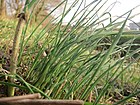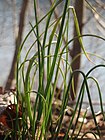Note: This is a project under development. The articles on this wiki are just being initiated and broadly incomplete. You can Help creating new pages.
Allium schoenoprasum - Chives
Chives is the common name of Allium schoenoprasum, an edible species of the Allium genus.A perennial plant, it is widespread in nature across much of Europe, Asia, and North America.
Contents
[hide]Uses
Cancer, Stomach cancer, Sleeping problems, Bone health.
Parts Used
Chemical Composition
A comprehensive chemical study of the cultivated plant Allium schoenoprasum L. from the collection of the Botanical Garden of the Institute of Biology (Komi Scientific Center, UB, RAS) showed that its leaves contained a wide range of biologically active substances and trace elements involved in the antioxidant and anticarcinogenic protection system of humans.[1]
Common names
| Language | Common name |
|---|---|
| Kannada | |
| Hindi | |
| Malayalam | |
| Tamil | |
| Telugu | |
| Marathi | NA |
| Gujarathi | NA |
| Punjabi | NA |
| Kashmiri | NA |
| Sanskrit | |
| English | Agrimony |
Habit
Identification
Leaf
| Kind | Shape | Feature |
|---|---|---|
| Simple | shorter | Leaves, which are shorter than the flowering stems, are also hollow and round in cross-section, which distinguishes it from Garlic Chives |
Flower
| Type | Size | Color and composition | Stamen | More information |
|---|---|---|---|---|
| Unisexual | 2-4cm long | pale purple | six petals | The flowers are pale purple, and star-shaped with six petals, 12 cm wide, and produced in a dense head of 10-30 together |
Fruit
| Type | Size | Mass | Appearance | Seeds | More information |
|---|---|---|---|---|---|
| Quite round | 12 cm wide | Fruiting time is June-July | The seeds are produced in a small three-valved capsule | {{{6}}} |
Other features
List of Ayurvedic medicine in which the herb is used
- Vishatinduka Taila as root juice extract
Where to get the saplings
Mode of Propagation
How to plant/cultivate
Chives are cultivated both for their culinary uses and their ornamental value; the violet flowers are often used in ornamental dry bouquets.[34] The flowers are also edible and are used in salads,[35] or used to make Blossom vinegars.[3]
Commonly seen growing in areas
Woodland Garden Sunny Edge, Hedgerow, Cultivated Beds.
Photo Gallery
References
External Links
- Ayurvedic Herbs known to be helpful to treat Cancer
- Ayurvedic Herbs known to be helpful to treat Stomach cancer
- Ayurvedic Herbs known to be helpful to treat Sleeping problems
- Ayurvedic Herbs known to be helpful to treat Bone health
- Herbs with Leaves used in medicine
- Herbs with Roots used in medicine
- Herbs with common name in English
- Habit - Perennial plant
- Index of Plants which can be propagated by Seeds
- Index of Plants which can be propagated by Cuttings
- Herbs that are commonly seen in the region of Woodland Garden Sunny Edge
- Herbs that are commonly seen in the region of Hedgerow
- Herbs that are commonly seen in the region of Cultivated Beds







